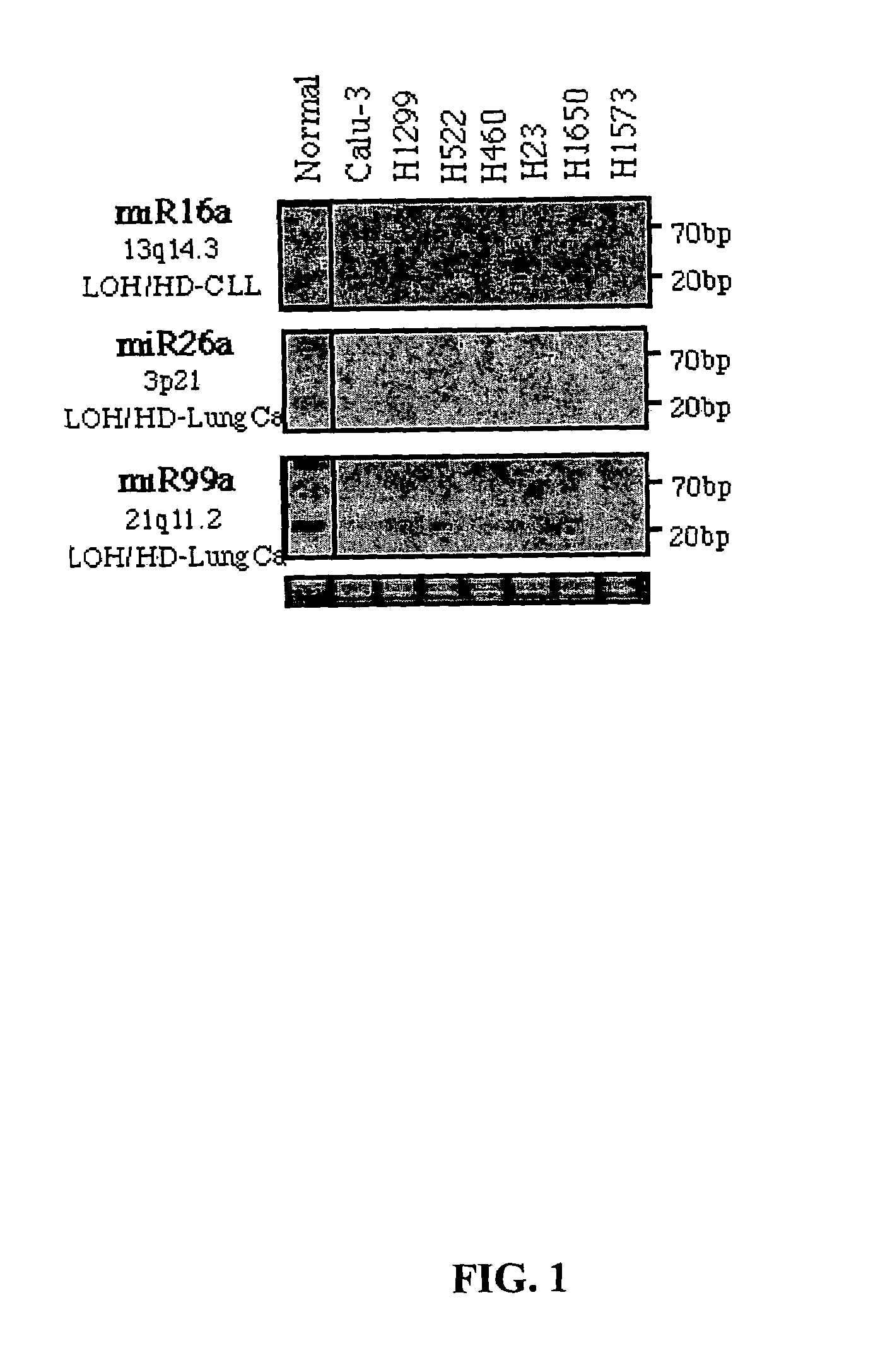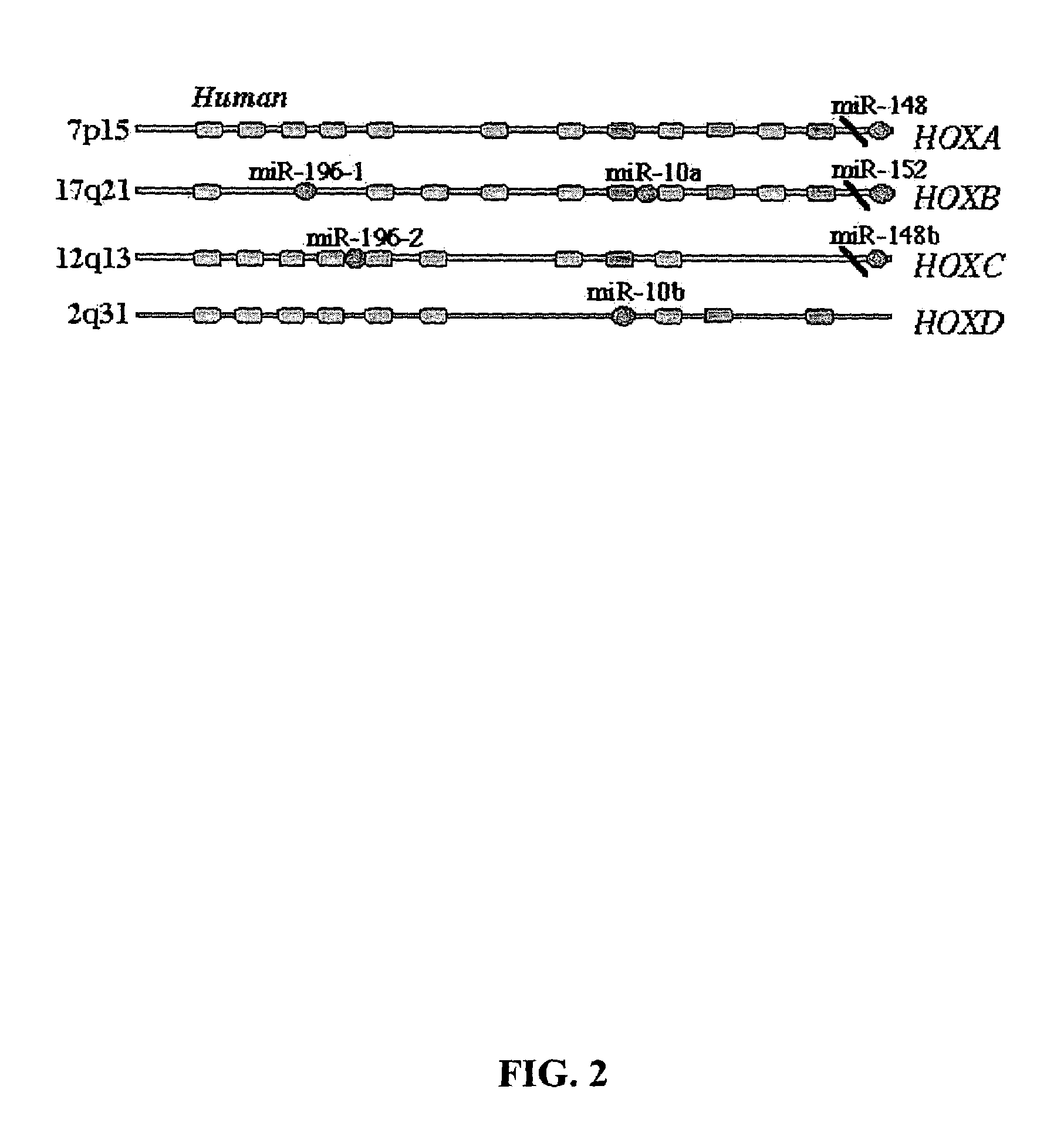Diagnosis and treatment of cancers with microRNA located in or near cancer associated chromosomal features
a cancer and chromosomal feature technology, applied in the field of diagnosis of cancers, can solve the problems of large amplification, deletion or rearrangement near the integration site, abnormally high gaps or breaks, and researchers are unable to develop treatments or diagnostic tests which cover more than a few types of cancer
- Summary
- Abstract
- Description
- Claims
- Application Information
AI Technical Summary
Benefits of technology
Problems solved by technology
Method used
Image
Examples
example 1
miR Genes are Non-Randomly Distributed in the Human Genome
[0176]One hundred eighty-six human genes representing known or predicted miR genes were mapped, based on mouse homology or computational methods, as described above in the General Methods. The results are presented in Table 2. The names were as in the miRNA Registry; for new miR genes, sequential names were assigned. miR 213 from Sanger database is different from miR 213 described in Lim et al. (2003, Science 299:1540). MiR genes in clusters are separated by a forward slash “ / ”. The approximate location in Mb of each clone is presented in the last column.
[0177]
TABLE 2miR Database: Chromosome Location and ClusteringChromosomeLoc (Mb)NamelocationGenes in Cluster(built 33)let-7a-109q22.2let-7a-1 / let-7f-1 / let-7d90.2-.3let-7a-211q24.1miR-125b-1 / let-7a-2 / miR-100 121.9-122.15let-7a-322q13.3let-7a-3 / let-7b44.7-.8let-7b22q13.3let-7a-3 / let-7b44.7-.8let-7c21q11.2miR-99a / let-7c / miR-125b-216.7-.9let-7d09q22.2let-7a-1 / let-7f-1 / let7d90.2-....
example 2
miR Genes are Located in or Near Fragile Sites
[0182]Thirty-five of 186 miRs (19%) were found in (13 miR genes), or within 3 Mb (22 miR genes) of cloned fragile sites (FRA). A set of 39 fragile sites with available cloning information was used in the analysis. Data were available for the exact dimension (mean 2.69 Mb) and position of ten of these cloned fragile sites (see General Methods above). The relative incidence of miR genes inside fragile sites occurred at a rate 9.12 times higher than in non-fragile sites (p<0.001, using mixed effect Poisson regression models; see Tables 3 and 4). The same very high statistical significance was also found when only the 13 miRs located exactly inside a FRA or exactly in the vicinity of the “anchoring” marker mapped for a FRA were considered (IRR=3.21, p<0.001). Among the four most active common fragile sites (FRA3B, FRA16D, FRA6E, and FRA7H), the data demonstrate seven miRs in (miR-29a and miR-29b) or close (miR-96, miR-182s, miR-182as, miR-18...
example 3
miR Genes are Located in or Near Human Papilloma Virus (HPV) Integration Sites
[0185]Because common fragile sites are preferential targets for HPV16 integration in cervical tumors, and infection with HPV16 or HPV18 is the major risk factor for developing cervical cancer, the association between miR gene locations and HPV16 integration sites in cervical tumors was analyzed. The data indicate that thirteen miR genes (7%) are located within 2.5 Mb of seven of seventeen (45%) cloned integration sites. The relative incidence of miRs at HPV16 integration sites occurred at a rate 3.22 times higher than in the rest of the genome (p<0.002) (Tables 4 and 5). In one cluster of integration sites at chromosome 17q23, where three HPV16 integration sites are spread over roughly 4 Mb of genomic sequence, four miR genes (miR-21, miR-301, miR-142s and miR-142as) were found.
[0186]
TABLE 5Analyzed FRA Sites, Cancer Correlation and HPV Integration SitesDistanceLocationmiR-HPV16SymbolChromosomeCancer corre...
PUM
| Property | Measurement | Unit |
|---|---|---|
| genomic structure | aaaaa | aaaaa |
Abstract
Description
Claims
Application Information
 Login to View More
Login to View More - R&D
- Intellectual Property
- Life Sciences
- Materials
- Tech Scout
- Unparalleled Data Quality
- Higher Quality Content
- 60% Fewer Hallucinations
Browse by: Latest US Patents, China's latest patents, Technical Efficacy Thesaurus, Application Domain, Technology Topic, Popular Technical Reports.
© 2025 PatSnap. All rights reserved.Legal|Privacy policy|Modern Slavery Act Transparency Statement|Sitemap|About US| Contact US: help@patsnap.com



